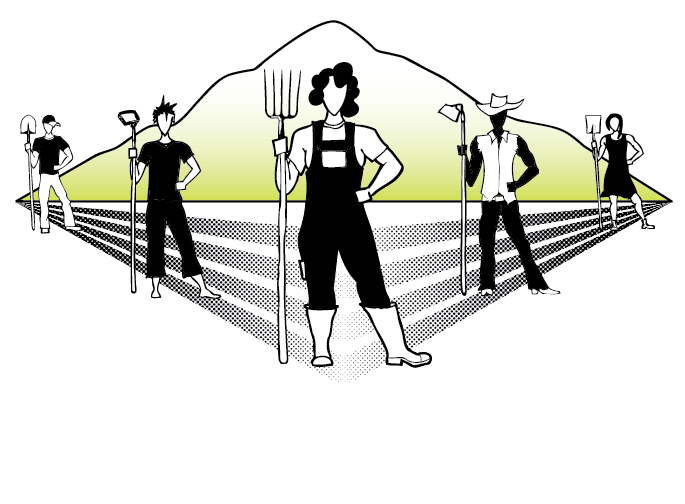“I fell in love with growing a lot of food as a way to make money and bring people together,” says Karyn Williams of Red Dog Farm. “But I had no idea if farming is what I should do. I needed to try it.” Leasing land proved essential to providing both the experience and community Williams needed to build a thriving farm business on the Olympic Peninsula in Washington.
“I had a great time and made tons of mistakes. I found such a supportive community,” she said. While leasing was a great trial, Williams wasn’t able to care for the land like she wanted to. “You never get on top of weeds. You’re always farming from spring to fall and you miss the whole winter cycle. You can’t put down roots.” An annual lease could also be nerve wracking: “Do I plant the garlic or not?”
Williams was ready to purchase her own farm: “I decided, I’m ready to make a commitment and be a better farmer.”
As she started to put out feelers for farmland in her community, Jefferson Land Trust stepped up as a critical partner. “I wouldn’t have been able to purchase my farm without Jefferson Land Trust,” she says. For the Land Trust, after decades of salmon habitat protection, this was their part of their initial efforts to preserve farmland.
Williams had her eye on 23 acres of a former dairy for sale by an elderly widow. It was prime farmland, but it was also a blank slate—it would take a lot of money just to build up operations for the farm. The Land Trust was able to provide a bridge for Red Dog Farm—they purchased the farm with a loan from Craft 3, a non-for-profit lending institution that works in partnership with the Land Trust. Then, they started leasing to Williams with the intent that they would put a conservation easement on the farm, permanently preserving the land and reducing the cost of the land, and Williams would purchase the land within five years.
Importantly, the lease was a ground lease agreement. Williams could put in infrastructure like irrigation and, if she wanted to walk away from the land, she could get the value of that investment out. Williams built up the three years of good credit she needed to secure a low interest loan through the Farm Service Agency’s Beginning Farmer loan program and purchased the land ahead of schedule.
During the leasing period, Williams and the Land Trust were able to figure out a conservation easement that worked for the farm operations and allowed them to preserve and restore critical salmon habitat along the river. The easement, Williams says, “Matches perfectly what is going on with the land and what my needs are. It helped a lot to be out there and farming and know the land before the easement was mapped that way.”
Sarah Spaeth from the Land Trust says it was critical to ensure generational transfer of land. “Easements set the elder generation up for retirement and make it more affordable for the next generation to come in,” she said.
This work has been part of a larger collaborative called Jefferson LandWorks. The Land Trust has been able to preserve 1063 acres of farmland to date. “We’re not just about protecting habitat, we’re about having thriving local economy. This work has changed the face of the community of Chimacum. It’s brought back young people to an aging community,” she said.
Williams has built Red Dog into a steady year-round business with 14 full-time and two part-time employees. She’s worked with other key service providers to help business grow. When she first started, she worked with the local Small Business Development Center on business planning. “We would go over our financials every month, it was so overwhelming at first—having this support was really helpful. They would identify when things were going well and asked good questions.”
As part of Northwest Farm Credit Services Ag Vision program, Williams got training and additional loans. “Ag Vision has all kinds of benefits. A technology stipend helped me buy a computer, and they would pay for me to go to conferences. Their counselors really coached me on profit and loss statements. I have a lot of loans, but the good news is that I’m able to make the payments and the interest rates are good,” she says.
Red Dog now sells 150 varieties of vegetables, berries, and cut flowers to direct wholesale and restaurants, and they have a farm stand. Williams was able to take a step back this year to be with her newborn and let the farm manager run the show. “It’s been really inspiring for me to know that the systems are working,” she said.
In 2020, Red Dog Farm will expand to lease new Land Trust farmland as part of a mixed-use development that may ultimately provide the next crucial piece of a thriving local agricultural economy: affordable housing for farmworkers.
Photo: 2019 Red Dog Farm Crew

